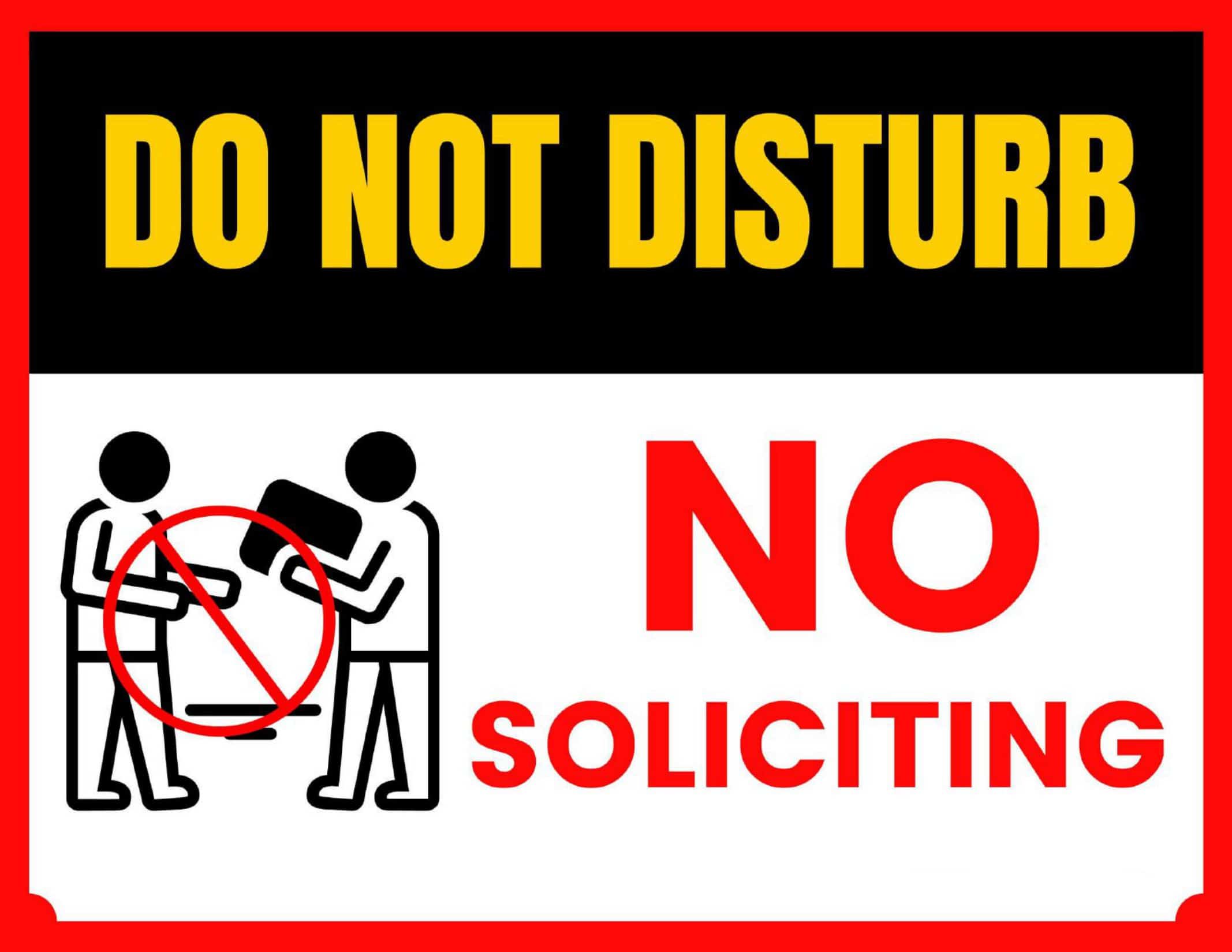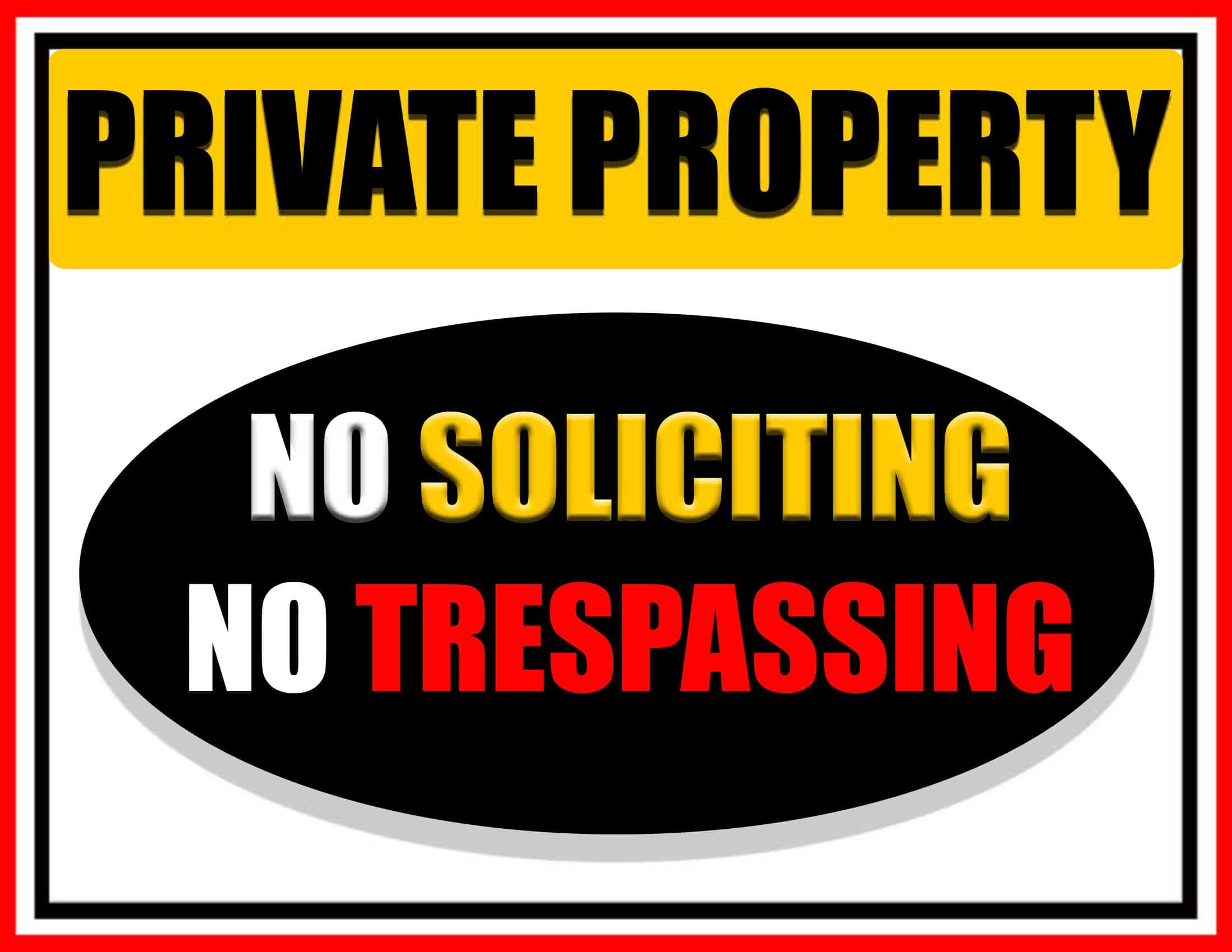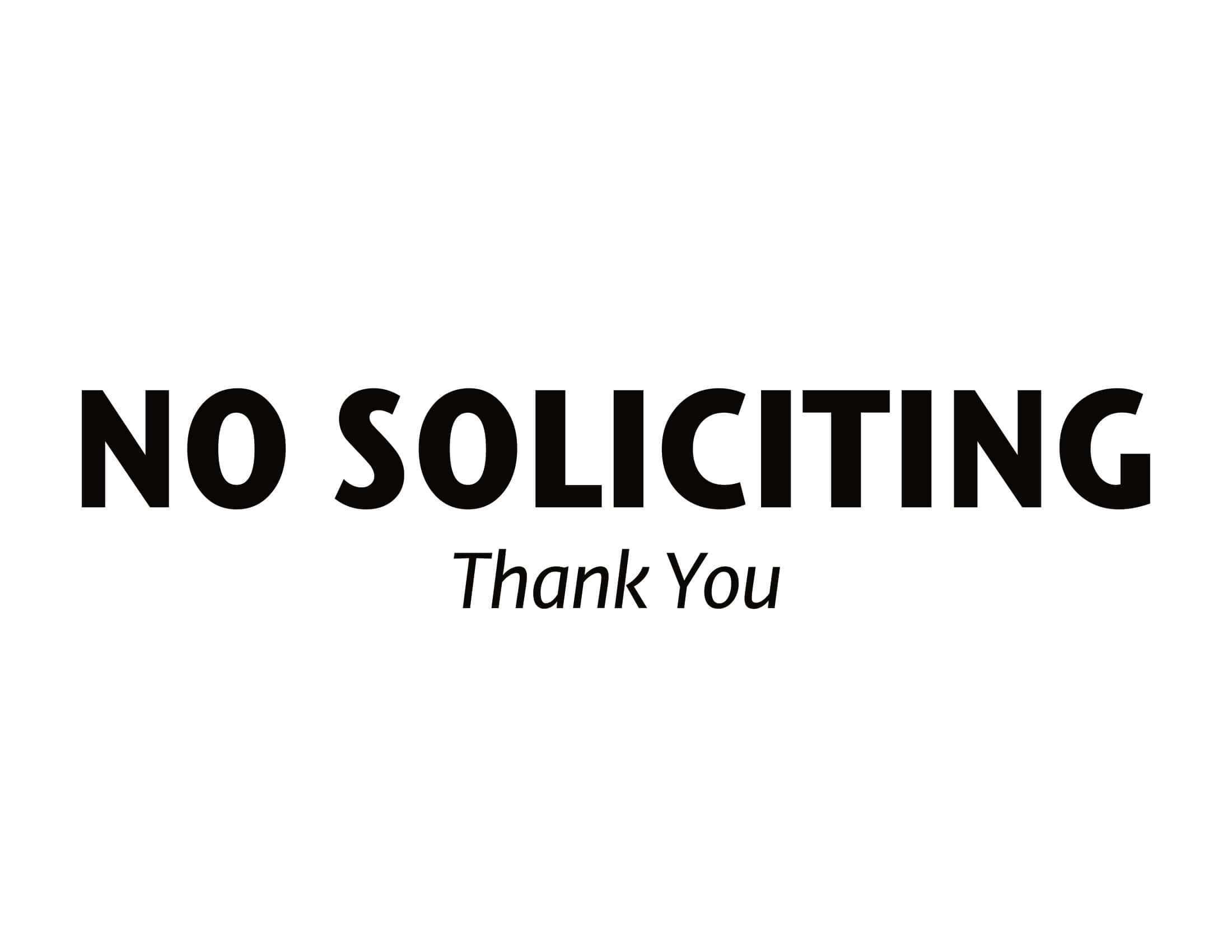Preventing unwanted solicitors requires clear signage indicating restrictions. While pre-made no soliciting signs are available, customized and durable options get pricey. This article offers free printable DIY templates for creating versatile no soliciting signs as needed. Our designs allow easy customization with concise messaging, applicable hours, and permit details. Print with weatherproof materials like rigid plastic, vinyl, or heavy laminated paper for long-lasting signs.
Prominent posting at property access points gives uninvited salespeople advance notice to avoid wasted trips and disturbances. For homeowners trying to stop interruptions or businesses maintaining standards, these budget-friendly printable signs provide a simple solution. Follow our guide for proper placement based on local laws. Quickly generate affordable no soliciting signage on demand using our handy templates.
Table of Contents
No Soliciting Sign Templates
A no soliciting sign indicates that door-to-door sales and promotions are prohibited on a property. It communicates that solicitations are not welcome. A no soliciting sign template provides a standardized design.
The sign features clear text such as “No Soliciting” or “No Solicitors”. Some versions also incorporate explanatory details of which activities are restricted. Visual symbols like a hand with a stop gesture reinforce the message. The versatile template can be posted outdoors or inside.
Posting a visible no soliciting signage informs salespeople and promoters that residents do not wish to be disturbed. The familiar template quickly conveys this directive to any passersby. Standardized messaging prevents unwanted intrusions and establishes clear expectations. A quality template ensures durability for prominent outdoor display.
Why No Soliciting Signs are Necessary

“No Soliciting” signs are considered necessary for a variety of reasons, depending on the context and the needs or desires of those who display them. These signs serve as an important form of communication between property owners or occupants and would-be visitors.
While not every jurisdiction legally enforces “No Soliciting” signs, they are broadly understood to indicate that unsolicited sales or promotional activities are not welcome on the premises. Here are some detailed reasons why these signs are considered necessary:
Personal Privacy
- Sanctity of Home: One’s home is often viewed as a personal sanctuary. Uninvited visitors, particularly those engaged in solicitation, can feel like an invasion of privacy.
- Family Time: For families, especially those with young children or elderly relatives, unexpected interruptions can disrupt precious family time.
- Remote Work: As remote work becomes more common, home is also a workplace for many. Unsolicited interruptions can be especially disruptive during work hours.
Safety Concerns
- Stranger Danger: Not all solicitors have good intentions; some may be casing the home for potential burglary or other crimes.
- Vulnerability: Elderly individuals or those living alone may be particularly vulnerable to scams or aggressive sales tactics.
Control Over Commercial Activity
- Consumer Choice: Individuals generally prefer to seek out products or services when they are interested, rather than being approached unsolicited.
- Hard Sell: Unsolicited sellers often employ high-pressure tactics, which many find uncomfortable or distressing.
Community Considerations
- Limited Interruption: In multi-family dwellings like apartment complexes, a “No Soliciting” sign helps limit interruptions to a larger number of residents.
- Uniformity: In a neighborhood, if most houses have “No Soliciting” signs, it discourages solicitors from targeting the area, benefiting all residents.
Legal Boundaries
- Trespass Laws: The sign can serve as a first warning, making it easier to prosecute for trespassing if the sign is ignored.
- Local Ordinances: Many localities have laws against soliciting without a permit, and a “No Soliciting” sign reinforces these rules.
Specific Needs and Preferences
- Personal Beliefs: Some may have religious or ethical reasons for not wanting to be approached by certain types of organizations.
- Pet Concerns: Homes with pets may use the signs to prevent the door from being knocked or rung, which could agitate animals.
Business Context
- Focus on Productivity: Businesses often post these signs to ensure that employees are not interrupted by unsolicited sales pitches.
- Security Protocols: For businesses with secure entrances or sensitive information, limiting unsolicited visitors can be a security measure.
Psychological Comfort
- Clear Boundaries: The sign sets a clear boundary, giving the homeowner a sense of control over their environment.
- Avoids Confrontation: For those who find it difficult to say no, the sign serves as a non-confrontational way to decline unsolicited offers.
Types of No Soliciting Signs
“No Soliciting” signs come in various types and designs to suit different needs, environments, and preferences. The type of sign selected can influence how effectively it communicates the property owner’s intention and how it fits aesthetically with its surroundings. Below are some common types of “No Soliciting” signs:
Traditional Metal or Plastic Signs
These are perhaps the most common and recognizable forms of “No Soliciting” signs. Made from durable materials like metal or hard plastic, these signs are designed to withstand the elements and are usually affixed to a wall, fence, or post near the entryway of a home or business. They often come in standardized colors like black and white or red and white, making them easily visible. The primary advantage of these signs is their longevity and clear, straightforward messaging. However, their utilitarian look may not be aesthetically pleasing to everyone and could clash with the overall design of the property.
Custom or Decorative Signs
Increasingly, homeowners are opting for custom or decorative “No Soliciting” signs that better match their personal style or the aesthetic of their home. These signs can be made from a variety of materials, including wood, ceramic, or even glass, and often feature creative fonts, illustrations, or additional text that injects humor or personality into the message. For example, a custom sign might read, “No Soliciting, Seriously, We’re Too Broke to Buy Anything.” While these signs make a unique statement and can serve as a decorative piece, they might not be as immediately recognizable or as durable as their traditional counterparts.
Window or Door Decals
Window or door decals are adhesive-based signs that can be easily applied directly to the glass of a front door or adjacent window. They are less permanent than metal or plastic signs and offer more flexibility in terms of placement and removal. This type of sign is particularly useful for people living in rental properties where drilling holes to mount a traditional sign may not be permitted. Decals are generally understated, seamlessly blending into the property’s appearance. However, they may be less visible from a distance and might deteriorate more quickly due to exposure to sunlight and weather conditions.
Digital or Electronic Signs
While less common for residential use, digital or electronic “No Soliciting” signs are sometimes used in commercial settings. These signs often come equipped with LED lights and can even include motion sensors that trigger the sign to illuminate or flash when someone approaches. In more advanced setups, they might be integrated into a larger security system. These high-tech signs can be highly effective in drawing attention to the no-soliciting policy, especially in low-light conditions. However, they tend to be more expensive, may require a power source, and could be viewed as overly aggressive or impersonal by some.
Legal and Regulatory Aspects
The legal and regulatory aspects surrounding “No Soliciting” signs can be complex and are subject to variation depending on jurisdiction, the nature of the property, and the specific activities being discouraged. Here’s a detailed overview:
General Legal Guidelines for No Soliciting Signs
In general, property owners in many jurisdictions have the right to display “No Soliciting” signs as an expression of their wish to be left alone. The sign typically serves as a warning that those who enter the property for the purpose of solicitation are not welcome. While the presence of a “No Soliciting” sign may not always be sufficient for legal prosecution, it can sometimes be used to enhance a case against trespassers, especially if local or state laws include anti-solicitation statutes.
It’s important to note that free speech protections can sometimes conflict with no-soliciting rules, especially in the case of religious proselytizing or political canvassing. Courts often have to weigh the right of individuals to engage in these activities against the property owner’s right to privacy and freedom from disturbance.
State or Country-Specific Regulations
The enforceability of “No Soliciting” signs can vary significantly based on local and state laws, or even country-specific regulations. In the United States, for example, municipalities often have their own bylaws governing solicitation, and permits may be required for certain types of solicitation. Some local ordinances may dictate the size, placement, and visibility of “No Soliciting” signs. In other countries, the rules surrounding solicitation can be vastly different, sometimes with a more lenient or stringent approach.
In some European countries, for instance, door-to-door selling and other forms of unsolicited marketing are subject to tight regulations, which could make “No Soliciting” signs somewhat redundant. On the other hand, in countries with fewer regulations, the signs might have less legal weight but serve as a strong social or cultural signal to would-be solicitors.
How “No Soliciting” Laws Differ by Location
Laws and ordinances governing solicitation activities and the enforceability of “No Soliciting” signs can differ widely by location, even within the same country or state. In some U.S. states, for example, the law might differentiate between commercial solicitation and non-commercial activities like religious or political canvassing. In certain jurisdictions, “No Soliciting” signs may only be legally enforceable against commercial solicitations but may not prevent individuals from knocking on doors for religious or political reasons.
In apartment complexes or gated communities, the legality of “No Soliciting” signs can become even more complex. The property management or homeowners association might have its own set of rules that either supplement or supersede local laws.
How to Make a Printable No Soliciting Sign
Creating a printable “No Soliciting” sign at home is a simple process that can be completed using common tools and software. Here’s a step-by-step guide:
Step 1: Determine the Design Requirements
First, you’ll want to consider the size of the sign and the materials on which you’ll be printing it. Will you use standard letter-size paper, or do you have something larger in mind? This will affect how you set up your document. Also, decide on the aesthetics: Do you want a simple black-and-white sign, or are you interested in incorporating color?
The design elements you choose should be visible and easily understandable to anyone approaching your property. Consider factors like readability from a distance and how the sign will look when printed. Remember, the sign not only serves a practical function but also represents your property, so make it look professional.
Step 2: Open a Graphics Software
Once you’ve determined your design requirements, open a graphics software program where you’ll create your sign. Programs like Adobe Illustrator, Photoshop, or free alternatives like GIMP, are suitable for this. For a simpler option, Microsoft Word or Google Docs can also suffice. Create a new file and set the document size to match the physical dimensions you’ve decided on. Most software programs will allow you to easily set the dimensions when creating a new document. Make sure to set the document to a high resolution (at least 300 DPI) for better print quality.
Step 3: Create the Design
Now comes the creative part. Use text tools to insert your “No Soliciting” message. Make sure to choose a clear, easily readable font. Add any additional information or images that you want to include, being mindful of readability and aesthetics. You can also add design elements like borders or background colors at this stage. Balance is key: while you may want the sign to look attractive, the primary purpose is to communicate a clear message. Before finalizing, preview the design multiple times, checking for any errors or design issues. Make adjustments as needed until you’re satisfied.
Step 4: Save and Review
Once your design is complete, save it in a format that’s suitable for printing. Common formats include PDF, JPEG, or PNG. Before you print, it’s advisable to do a final review. If possible, show it to a few other people for their opinions; sometimes, a fresh set of eyes can catch mistakes or suggest useful improvements. Ensure that the design is centered and fits well within the dimensions you’ve chosen, and check one last time for any typos or design errors.
Step 5: Print and Laminate
With your design finalized and saved in a printable format, it’s time to print. Use high-quality paper for durability; if your printer allows it, cardstock is a good option. Make sure your printer settings match the design specifications for size and layout. After printing, check to ensure the colors and text look as they should. For added durability, consider laminating the sign. Many office supply stores offer inexpensive laminating services, or you can do it yourself if you have access to a laminator.
Step 6: Installation
The final step is to install your printed sign. The method you choose will depend on where you want the sign to go. For attaching it to a wall or fence, you might use nails, screws, or adhesive strips. If you’re placing it on a window, suction cups or adhesive window film could be effective. Before you install, make sure to clean the surface to which you’ll be attaching the sign; this will make it adhere better and last longer.
Funny No Soliciting Signs: Add Some Wit to Your Warnings
While No Soliciting signs primarily serve a practical purpose, who says they can’t also deliver a chuckle or two? At TypeCalendar, we offer an assortment of funny No Soliciting Signs that add a dash of humor to your message. Imagine a sign that not only deters unsolicited visits but also makes anyone who reads it smile. Perhaps it warns potential solicitors that a ‘very convincing toddler’ lives on the property, or that ‘solicitors will be fed to the dragon.’ Available in customizable Word formats, you can even add your unique spin to our funny templates, ensuring your message is not just heard but also thoroughly enjoyed.
Hassle-Free No Soliciting Signage Courtesy of TypeCalendar
We know that your time is valuable, which is why we’ve made the process of downloading and printing our No Soliciting Signs as hassle-free as possible. Simply visit the TypeCalendar website, navigate to the No Soliciting Sign section, choose your preferred format, and you’re all set! Our signs are formatted to print perfectly on standard paper sizes, and their quality remains consistently high whether you’re printing a small sign for a residential mailbox or a larger sign to display in a corporate lobby. With TypeCalendar’s free printable No Soliciting Signs, you can now easily communicate your boundaries while also enjoying a bit of humor.
Free Printable No Soliciting Signs Now Available on TypeCalendar
For businesses and homeowners alike, unsolicited visits can often be an unwanted interruption. Whether it’s door-to-door salespeople, unwanted services, or other forms of cold-calling, the invasion of private space can become an annoyance. Recognizing this need for clearer boundaries, TypeCalendar is excited to introduce our collection of free printable No Soliciting Signs.
Available in both PDF and Word formats, our signs are designed to offer a straightforward yet effective means of communicating your no-soliciting policy to potential intruders. Simply download, print, and display to ensure your space remains as peaceful as you’d like.
Download Your No Soliciting Sign and Reclaim Your Space
In today’s fast-paced world, uninterrupted time is more valuable than ever. Whether it’s an important meeting in the office or some much-needed downtime at home, you shouldn’t have to deal with unwanted disruptions. Our No Soliciting Signs come in easily downloadable Word and PDF formats, offering you the flexibility to tailor the sign’s look or message to fit your specific needs. Made to suit all environments, from corporate to residential, our signs serve as an unambiguous, professional-looking deterrent to unwanted solicitation.


































![%100 Free Hoodie Templates [Printable] +PDF 1 Hoodie Template](https://www.typecalendar.com/wp-content/uploads/2023/05/Hoodie-Template-1-150x150.jpg)
![Free Printable Food Diary Templates [Word, Excel, PDF] 2 Food Diary](https://www.typecalendar.com/wp-content/uploads/2023/05/Food-Diary-1-150x150.jpg 150w, https://www.typecalendar.com/wp-content/uploads/2023/05/Food-Diary-1-1200x1200.jpg 1200w)
![Free Printable Roommate Agreement Templates [Word, PDF] 3 Roommate Agreement](https://www.typecalendar.com/wp-content/uploads/2023/06/Roommate-Agreement-150x150.jpg)
